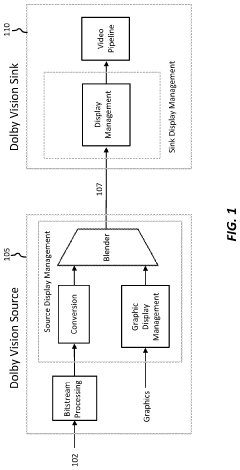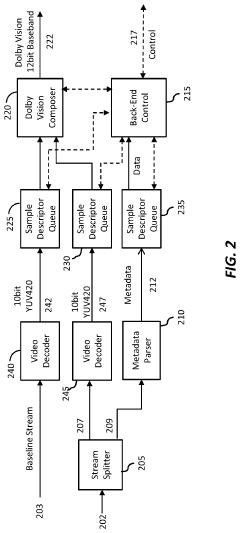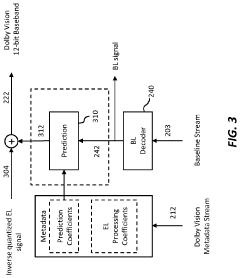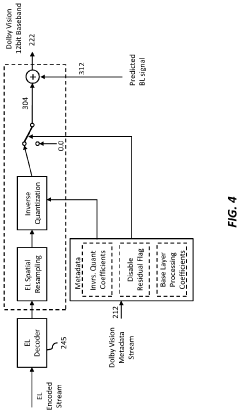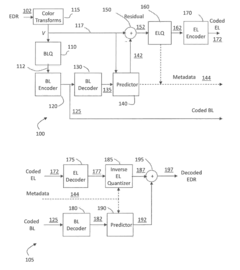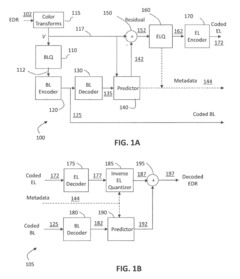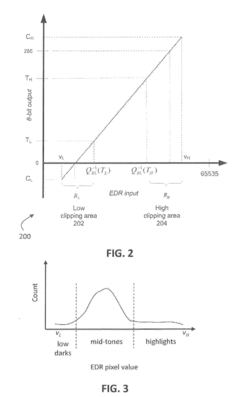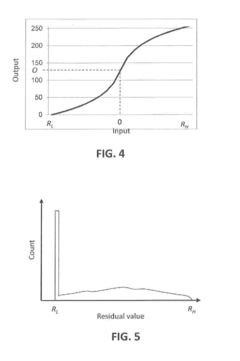Exploring Dolby Vision’s Advantages in Remote Learning Platforms
JUL 30, 20259 MIN READ
Generate Your Research Report Instantly with AI Agent
Patsnap Eureka helps you evaluate technical feasibility & market potential.
Dolby Vision in E-Learning: Background and Objectives
Dolby Vision, a cutting-edge HDR (High Dynamic Range) technology, has been making significant strides in various industries, including entertainment and consumer electronics. As the world increasingly shifts towards remote learning platforms, the potential application of Dolby Vision in e-learning environments presents an exciting opportunity for technological advancement and improved user experience.
The evolution of digital learning platforms has been accelerated by global events, such as the COVID-19 pandemic, which forced educational institutions to rapidly adopt online teaching methods. This sudden shift highlighted the importance of high-quality audio-visual experiences in maintaining student engagement and facilitating effective knowledge transfer in virtual classrooms.
Dolby Vision, with its superior color depth, brightness, and contrast capabilities, has the potential to revolutionize the visual aspect of remote learning. By providing a more immersive and lifelike viewing experience, it can help bridge the gap between traditional classroom settings and digital learning environments. The technology's ability to deliver consistent image quality across various devices and screen sizes is particularly relevant in the context of e-learning, where students may access content through a range of devices, from smartphones to large monitors.
The primary objective of exploring Dolby Vision's advantages in remote learning platforms is to enhance the overall quality of visual content delivery. This includes improving the clarity and detail of educational materials, such as diagrams, charts, and video lectures, which are crucial for effective learning. By leveraging Dolby Vision's advanced color grading and dynamic metadata capabilities, educational content creators can ensure that their materials are presented with optimal visual fidelity, regardless of the viewing device or ambient lighting conditions.
Furthermore, the integration of Dolby Vision into e-learning platforms aims to address some of the key challenges faced in remote education, such as student engagement and information retention. The enhanced visual experience provided by Dolby Vision has the potential to capture and maintain student attention more effectively, leading to improved learning outcomes. This is particularly important in subjects that rely heavily on visual aids, such as science, art, and engineering.
As we delve deeper into the potential of Dolby Vision in e-learning, it is essential to consider the technical requirements and infrastructure needed to support this technology across various educational institutions and platforms. This exploration will also involve assessing the scalability of Dolby Vision implementation in diverse learning environments and its compatibility with existing e-learning tools and content management systems.
The evolution of digital learning platforms has been accelerated by global events, such as the COVID-19 pandemic, which forced educational institutions to rapidly adopt online teaching methods. This sudden shift highlighted the importance of high-quality audio-visual experiences in maintaining student engagement and facilitating effective knowledge transfer in virtual classrooms.
Dolby Vision, with its superior color depth, brightness, and contrast capabilities, has the potential to revolutionize the visual aspect of remote learning. By providing a more immersive and lifelike viewing experience, it can help bridge the gap between traditional classroom settings and digital learning environments. The technology's ability to deliver consistent image quality across various devices and screen sizes is particularly relevant in the context of e-learning, where students may access content through a range of devices, from smartphones to large monitors.
The primary objective of exploring Dolby Vision's advantages in remote learning platforms is to enhance the overall quality of visual content delivery. This includes improving the clarity and detail of educational materials, such as diagrams, charts, and video lectures, which are crucial for effective learning. By leveraging Dolby Vision's advanced color grading and dynamic metadata capabilities, educational content creators can ensure that their materials are presented with optimal visual fidelity, regardless of the viewing device or ambient lighting conditions.
Furthermore, the integration of Dolby Vision into e-learning platforms aims to address some of the key challenges faced in remote education, such as student engagement and information retention. The enhanced visual experience provided by Dolby Vision has the potential to capture and maintain student attention more effectively, leading to improved learning outcomes. This is particularly important in subjects that rely heavily on visual aids, such as science, art, and engineering.
As we delve deeper into the potential of Dolby Vision in e-learning, it is essential to consider the technical requirements and infrastructure needed to support this technology across various educational institutions and platforms. This exploration will also involve assessing the scalability of Dolby Vision implementation in diverse learning environments and its compatibility with existing e-learning tools and content management systems.
Market Analysis for Enhanced Video Quality in Remote Education
The remote education market has experienced significant growth in recent years, driven by technological advancements and the increasing demand for flexible learning options. The COVID-19 pandemic has further accelerated this trend, with many educational institutions adopting remote learning platforms as a necessity. As a result, the market for enhanced video quality in remote education has expanded rapidly.
The global e-learning market size was valued at $197.00 billion in 2020 and is projected to reach $840.11 billion by 2030, growing at a CAGR of 17.5% from 2021 to 2030. Within this market, the demand for high-quality video content and streaming capabilities has become increasingly important. Students and educators alike are seeking immersive and engaging learning experiences that can replicate the in-person classroom environment as closely as possible.
Enhanced video quality, such as that offered by Dolby Vision, plays a crucial role in meeting these expectations. The market for advanced video technologies in remote education is driven by several factors, including the need for improved visual clarity, color accuracy, and overall viewing experience. These features are particularly important in subjects that rely heavily on visual aids, such as science, art, and engineering.
The adoption of enhanced video quality solutions in remote learning platforms is not uniform across different regions. Developed countries with robust internet infrastructure and higher education budgets are leading the way in implementing advanced video technologies. However, emerging markets are also showing significant growth potential as they invest in improving their digital education capabilities.
Key market segments for enhanced video quality in remote education include K-12 schools, higher education institutions, corporate training programs, and online course providers. Each of these segments has unique requirements and preferences, influencing the development and adoption of video quality solutions.
The competitive landscape in this market is characterized by a mix of established technology companies, specialized educational technology providers, and innovative startups. Major players are investing heavily in research and development to improve their video streaming and encoding technologies, with a focus on optimizing performance for various devices and network conditions.
Looking ahead, the market for enhanced video quality in remote education is expected to continue its growth trajectory. Factors such as the increasing penetration of high-speed internet, the proliferation of mobile devices, and the ongoing digital transformation of education will drive demand for superior video experiences in online learning environments. As technologies like Dolby Vision become more widely available and integrated into remote learning platforms, they have the potential to significantly enhance the quality and effectiveness of distance education.
The global e-learning market size was valued at $197.00 billion in 2020 and is projected to reach $840.11 billion by 2030, growing at a CAGR of 17.5% from 2021 to 2030. Within this market, the demand for high-quality video content and streaming capabilities has become increasingly important. Students and educators alike are seeking immersive and engaging learning experiences that can replicate the in-person classroom environment as closely as possible.
Enhanced video quality, such as that offered by Dolby Vision, plays a crucial role in meeting these expectations. The market for advanced video technologies in remote education is driven by several factors, including the need for improved visual clarity, color accuracy, and overall viewing experience. These features are particularly important in subjects that rely heavily on visual aids, such as science, art, and engineering.
The adoption of enhanced video quality solutions in remote learning platforms is not uniform across different regions. Developed countries with robust internet infrastructure and higher education budgets are leading the way in implementing advanced video technologies. However, emerging markets are also showing significant growth potential as they invest in improving their digital education capabilities.
Key market segments for enhanced video quality in remote education include K-12 schools, higher education institutions, corporate training programs, and online course providers. Each of these segments has unique requirements and preferences, influencing the development and adoption of video quality solutions.
The competitive landscape in this market is characterized by a mix of established technology companies, specialized educational technology providers, and innovative startups. Major players are investing heavily in research and development to improve their video streaming and encoding technologies, with a focus on optimizing performance for various devices and network conditions.
Looking ahead, the market for enhanced video quality in remote education is expected to continue its growth trajectory. Factors such as the increasing penetration of high-speed internet, the proliferation of mobile devices, and the ongoing digital transformation of education will drive demand for superior video experiences in online learning environments. As technologies like Dolby Vision become more widely available and integrated into remote learning platforms, they have the potential to significantly enhance the quality and effectiveness of distance education.
Current Challenges in Remote Learning Video Technology
Remote learning platforms have experienced unprecedented growth in recent years, particularly accelerated by global events such as the COVID-19 pandemic. However, this rapid expansion has exposed several critical challenges in video technology that hinder the effectiveness of online education. One of the primary issues is the inconsistent video quality across different devices and network conditions, which can significantly impact the learning experience.
Many remote learning platforms struggle to deliver high-quality video content consistently, especially in regions with limited bandwidth. This results in frequent buffering, pixelation, and audio-video synchronization problems, which can be particularly detrimental in educational settings where clear communication is crucial. The inability to maintain a stable, high-quality video stream often leads to reduced engagement and comprehension among students.
Another significant challenge is the lack of standardization in video formats and codecs across various devices and platforms. This diversity creates compatibility issues, forcing educational institutions to either limit their technology choices or invest heavily in multi-platform solutions. The fragmentation of video technologies also complicates content creation and distribution processes, potentially limiting the richness and interactivity of learning materials.
Color accuracy and dynamic range limitations in current video technologies pose additional challenges. Many remote learning platforms fail to accurately reproduce visual content, such as scientific diagrams, art pieces, or medical imagery, due to inadequate color depth and contrast ratios. This can lead to misinterpretation of visual information and compromise the learning outcomes in disciplines that heavily rely on precise visual representations.
The increasing demand for interactive and immersive learning experiences has also exposed the limitations of current video technologies. Many platforms struggle to integrate real-time annotations, 3D visualizations, or augmented reality elements seamlessly into video streams. This restricts the ability to create truly engaging and interactive remote learning environments that can rival in-person experiences.
Lastly, the challenge of accessibility in remote learning video technology remains a significant concern. Many platforms lack robust features for closed captioning, audio descriptions, or multi-language support, potentially excluding students with disabilities or non-native speakers from fully participating in online courses. Addressing these accessibility issues is crucial for ensuring inclusive education in the digital age.
Many remote learning platforms struggle to deliver high-quality video content consistently, especially in regions with limited bandwidth. This results in frequent buffering, pixelation, and audio-video synchronization problems, which can be particularly detrimental in educational settings where clear communication is crucial. The inability to maintain a stable, high-quality video stream often leads to reduced engagement and comprehension among students.
Another significant challenge is the lack of standardization in video formats and codecs across various devices and platforms. This diversity creates compatibility issues, forcing educational institutions to either limit their technology choices or invest heavily in multi-platform solutions. The fragmentation of video technologies also complicates content creation and distribution processes, potentially limiting the richness and interactivity of learning materials.
Color accuracy and dynamic range limitations in current video technologies pose additional challenges. Many remote learning platforms fail to accurately reproduce visual content, such as scientific diagrams, art pieces, or medical imagery, due to inadequate color depth and contrast ratios. This can lead to misinterpretation of visual information and compromise the learning outcomes in disciplines that heavily rely on precise visual representations.
The increasing demand for interactive and immersive learning experiences has also exposed the limitations of current video technologies. Many platforms struggle to integrate real-time annotations, 3D visualizations, or augmented reality elements seamlessly into video streams. This restricts the ability to create truly engaging and interactive remote learning environments that can rival in-person experiences.
Lastly, the challenge of accessibility in remote learning video technology remains a significant concern. Many platforms lack robust features for closed captioning, audio descriptions, or multi-language support, potentially excluding students with disabilities or non-native speakers from fully participating in online courses. Addressing these accessibility issues is crucial for ensuring inclusive education in the digital age.
Existing Dolby Vision Implementation in Remote Learning Platforms
01 Enhanced dynamic range and color depth
Dolby Vision technology offers improved dynamic range and color depth, resulting in more vibrant and lifelike images. This enhancement allows for a wider range of colors and brightness levels, providing a more immersive viewing experience.- Enhanced dynamic range and color depth: Dolby Vision technology offers superior dynamic range and color depth compared to standard video formats. It provides a wider range of brightness levels and a broader color gamut, resulting in more lifelike and vibrant images with improved contrast and detail in both bright and dark scenes.
- Adaptive scene-by-scene optimization: Dolby Vision employs advanced algorithms to analyze and optimize each scene individually. This adaptive approach ensures that every frame is displayed with optimal brightness, color, and contrast, resulting in a more consistent and immersive viewing experience across different content types and viewing environments.
- Improved compatibility and content delivery: Dolby Vision is designed to be backward compatible with existing display technologies while also supporting future advancements. It enables efficient content delivery through metadata-based encoding, allowing for seamless integration with various streaming platforms and devices, ensuring a high-quality viewing experience across different display capabilities.
- Enhanced audio-visual synchronization: Dolby Vision technology incorporates advanced audio-visual synchronization features, ensuring that the enhanced visual experience is perfectly aligned with high-quality audio. This integration results in a more immersive and cohesive multimedia experience, particularly beneficial for cinematic content and gaming applications.
- Energy-efficient display optimization: The technology behind Dolby Vision includes intelligent display optimization algorithms that can adjust brightness and contrast levels based on ambient lighting conditions and content characteristics. This not only enhances the viewing experience but also contributes to energy efficiency in display devices, potentially reducing power consumption without compromising image quality.
02 Scene-by-scene optimization
Dolby Vision employs dynamic metadata to optimize each scene individually, ensuring that the content is displayed with the best possible quality. This scene-by-scene approach allows for more accurate representation of the creator's intent.Expand Specific Solutions03 Compatibility with various display technologies
Dolby Vision is designed to work across a wide range of display technologies, from high-end OLED TVs to mobile devices. This versatility ensures that users can enjoy enhanced visual quality on multiple platforms and screen sizes.Expand Specific Solutions04 Improved brightness and contrast
The technology offers significantly improved brightness and contrast levels, allowing for more detailed highlights and deeper blacks. This enhancement contributes to a more realistic and engaging viewing experience, particularly in HDR content.Expand Specific Solutions05 Content creation and mastering tools
Dolby Vision provides content creators with advanced tools for mastering and grading their work. These tools enable more precise control over color and brightness, ensuring that the final product accurately represents the creator's artistic vision across different display devices.Expand Specific Solutions
Key Players in Educational Video Streaming and Dolby Vision
The exploration of Dolby Vision's advantages in remote learning platforms is at an early stage of development, with the market showing significant growth potential as educational institutions increasingly adopt advanced video technologies. The global e-learning market, estimated to reach $375 billion by 2026, provides a fertile ground for Dolby Vision's application. While the technology is mature in entertainment sectors, its adaptation for educational purposes is still evolving. Companies like Tata Consultancy Services and IBM are likely to play crucial roles in integrating Dolby Vision into existing e-learning platforms, leveraging their expertise in IT services and AI. Universities such as Huazhong University of Science & Technology and Beihang University may contribute to research and development efforts, potentially collaborating with tech giants like Tencent to optimize the technology for diverse educational contexts.
HP Development Co. LP
Technical Solution: HP has integrated Dolby Vision technology into its remote learning platforms, enhancing the visual experience for students and educators. Their solution leverages Dolby Vision's high dynamic range (HDR) capabilities to deliver more vibrant and lifelike images, with improved contrast and color accuracy. This is particularly beneficial for subjects that rely heavily on visual content, such as art, science, and geography. HP's implementation includes adaptive optimization algorithms that adjust the display settings based on ambient lighting conditions, ensuring optimal visibility regardless of the user's environment[1]. The company has also developed specialized software that enables real-time Dolby Vision encoding for live-streamed lectures, maintaining high image quality even with varying network conditions[3].
Strengths: Enhanced visual experience, adaptive optimization for various environments, improved engagement in visually-dependent subjects. Weaknesses: Requires compatible hardware, potential increased bandwidth requirements for high-quality streaming.
Beijing Century TAL Education Technology Co. Ltd.
Technical Solution: TAL Education has integrated Dolby Vision into its online tutoring and remote learning platforms, focusing on creating an engaging and immersive experience for K-12 students. Their implementation includes a feature that uses Dolby Vision to enhance 3D models and animations in science and mathematics courses, providing students with a more realistic and detailed view of complex concepts[7]. TAL has also developed a collaborative whiteboard tool that leverages Dolby Vision to improve the visibility of shared content, allowing for clearer communication between tutors and students. The platform includes a parent portal that uses Dolby Vision to display high-quality progress reports and visual analytics of their child's learning journey[8].
Strengths: Enhanced 3D visualizations for STEM subjects, improved collaborative tools, engaging parent-facing features. Weaknesses: May require specialized content creation for full benefit, potential increased costs for content development.
Core Innovations of Dolby Vision for Educational Content
Layered representation and delivery of high dynamic range video
PatentActiveUS20190373290A1
Innovation
- The implementation of a layered representation and delivery system for HDR video, utilizing Dolby Vision technology, which includes a base layer and enhancement layer, along with metadata processing to reconstruct HDR signals, ensuring seamless playback on compatible displays.
Layered Decomposition of Chroma Components in EDR Video Coding
PatentActiveUS20160065975A1
Innovation
- A dual-layer EDR video encoder employs joint adaptation of base layer and enhancement layer quantizers, optimizing parameter selection to minimize distortion and bit requirements, allowing for efficient coding and decoding of EDR video streams that can be rendered on both legacy and HDR displays.
Bandwidth and Compatibility Considerations for Dolby Vision
When implementing Dolby Vision in remote learning platforms, bandwidth and compatibility considerations are crucial for ensuring optimal performance and user experience. The high dynamic range (HDR) and wide color gamut capabilities of Dolby Vision require additional data transmission, potentially increasing bandwidth requirements. However, Dolby Vision's efficient encoding techniques help mitigate this impact.
Bandwidth consumption for Dolby Vision content varies depending on the specific implementation and content type. Generally, Dolby Vision adds a 10-15% overhead compared to standard HDR10 content. For remote learning platforms, this translates to an increased bitrate requirement of approximately 2-3 Mbps for high-quality 1080p streaming, and 5-7 Mbps for 4K content. While this increase is noticeable, it remains within reasonable limits for most broadband connections.
To address bandwidth constraints, Dolby Vision incorporates adaptive bitrate streaming techniques. This allows the system to dynamically adjust video quality based on available network conditions, ensuring smooth playback even in challenging network environments. Additionally, Dolby Vision's metadata-driven approach enables efficient delivery of enhanced visual information without significantly increasing file sizes.
Compatibility is another critical factor when considering Dolby Vision for remote learning platforms. While Dolby Vision support has expanded significantly in recent years, it is not universally available across all devices. Most modern smart TVs, high-end mobile devices, and some computer monitors support Dolby Vision. However, older or budget devices may lack this capability.
To ensure broad accessibility, remote learning platforms implementing Dolby Vision should adopt a fallback strategy. This involves providing alternative HDR formats like HDR10 or even standard dynamic range (SDR) versions of the content. The platform can then detect the capabilities of the user's device and deliver the most appropriate format.
It's worth noting that Dolby Vision's backwards compatibility features allow for graceful degradation on non-Dolby Vision displays. The content can still be displayed in standard HDR or SDR formats without loss of essential information, ensuring that all users can access the learning materials regardless of their display capabilities.
In conclusion, while Dolby Vision does introduce some bandwidth and compatibility challenges for remote learning platforms, these are manageable through efficient encoding, adaptive streaming techniques, and thoughtful implementation strategies. The potential benefits in terms of enhanced visual quality and improved learning experiences may outweigh these considerations for many educational institutions and content providers.
Bandwidth consumption for Dolby Vision content varies depending on the specific implementation and content type. Generally, Dolby Vision adds a 10-15% overhead compared to standard HDR10 content. For remote learning platforms, this translates to an increased bitrate requirement of approximately 2-3 Mbps for high-quality 1080p streaming, and 5-7 Mbps for 4K content. While this increase is noticeable, it remains within reasonable limits for most broadband connections.
To address bandwidth constraints, Dolby Vision incorporates adaptive bitrate streaming techniques. This allows the system to dynamically adjust video quality based on available network conditions, ensuring smooth playback even in challenging network environments. Additionally, Dolby Vision's metadata-driven approach enables efficient delivery of enhanced visual information without significantly increasing file sizes.
Compatibility is another critical factor when considering Dolby Vision for remote learning platforms. While Dolby Vision support has expanded significantly in recent years, it is not universally available across all devices. Most modern smart TVs, high-end mobile devices, and some computer monitors support Dolby Vision. However, older or budget devices may lack this capability.
To ensure broad accessibility, remote learning platforms implementing Dolby Vision should adopt a fallback strategy. This involves providing alternative HDR formats like HDR10 or even standard dynamic range (SDR) versions of the content. The platform can then detect the capabilities of the user's device and deliver the most appropriate format.
It's worth noting that Dolby Vision's backwards compatibility features allow for graceful degradation on non-Dolby Vision displays. The content can still be displayed in standard HDR or SDR formats without loss of essential information, ensuring that all users can access the learning materials regardless of their display capabilities.
In conclusion, while Dolby Vision does introduce some bandwidth and compatibility challenges for remote learning platforms, these are manageable through efficient encoding, adaptive streaming techniques, and thoughtful implementation strategies. The potential benefits in terms of enhanced visual quality and improved learning experiences may outweigh these considerations for many educational institutions and content providers.
Accessibility Impact of Dolby Vision in Remote Learning
Dolby Vision's implementation in remote learning platforms has the potential to significantly enhance accessibility for students with diverse needs. The advanced HDR technology offers improved contrast, color accuracy, and brightness, which can be particularly beneficial for learners with visual impairments. By providing a more vibrant and detailed visual experience, Dolby Vision can help students with low vision or color perception difficulties to better distinguish between different elements on the screen, making educational content more accessible and engaging.
For students with hearing impairments, Dolby Vision's enhanced visual quality can complement closed captioning and sign language interpretation. The improved clarity and detail in video content can aid in lip-reading and facial expression recognition, crucial aspects of communication for many deaf and hard-of-hearing learners. This enhanced visual experience can lead to better comprehension and participation in virtual classroom settings.
Moreover, Dolby Vision's ability to optimize content for various devices and screen types ensures a consistent, high-quality viewing experience across different platforms. This uniformity is particularly important for students with cognitive or attention disorders, as it reduces potential distractions caused by varying visual quality when switching between devices or learning environments.
The technology's dynamic metadata capabilities allow for real-time adjustments to brightness and color, which can be leveraged to create adaptive learning environments. For instance, the system could automatically adjust visual parameters based on individual student preferences or specific learning needs, further enhancing accessibility and personalization in remote education.
Dolby Vision's impact extends beyond visual improvements. The technology's ability to deliver more immersive and engaging content can benefit students with attention deficit disorders or those who struggle with maintaining focus during online lessons. By presenting educational material in a more visually appealing and dynamic manner, Dolby Vision can potentially increase student engagement and retention of information.
Furthermore, the enhanced visual quality provided by Dolby Vision can support the creation of more detailed and accurate visual aids, diagrams, and educational animations. This improvement in visual resources can be particularly beneficial for students with learning disabilities or those who rely heavily on visual learning strategies.
In conclusion, the integration of Dolby Vision in remote learning platforms has the potential to significantly enhance accessibility across a wide spectrum of learner needs. By providing a more vibrant, detailed, and consistent visual experience, this technology can help bridge the gap in digital education accessibility, ensuring that all students, regardless of their individual challenges, can fully participate in and benefit from remote learning environments.
For students with hearing impairments, Dolby Vision's enhanced visual quality can complement closed captioning and sign language interpretation. The improved clarity and detail in video content can aid in lip-reading and facial expression recognition, crucial aspects of communication for many deaf and hard-of-hearing learners. This enhanced visual experience can lead to better comprehension and participation in virtual classroom settings.
Moreover, Dolby Vision's ability to optimize content for various devices and screen types ensures a consistent, high-quality viewing experience across different platforms. This uniformity is particularly important for students with cognitive or attention disorders, as it reduces potential distractions caused by varying visual quality when switching between devices or learning environments.
The technology's dynamic metadata capabilities allow for real-time adjustments to brightness and color, which can be leveraged to create adaptive learning environments. For instance, the system could automatically adjust visual parameters based on individual student preferences or specific learning needs, further enhancing accessibility and personalization in remote education.
Dolby Vision's impact extends beyond visual improvements. The technology's ability to deliver more immersive and engaging content can benefit students with attention deficit disorders or those who struggle with maintaining focus during online lessons. By presenting educational material in a more visually appealing and dynamic manner, Dolby Vision can potentially increase student engagement and retention of information.
Furthermore, the enhanced visual quality provided by Dolby Vision can support the creation of more detailed and accurate visual aids, diagrams, and educational animations. This improvement in visual resources can be particularly beneficial for students with learning disabilities or those who rely heavily on visual learning strategies.
In conclusion, the integration of Dolby Vision in remote learning platforms has the potential to significantly enhance accessibility across a wide spectrum of learner needs. By providing a more vibrant, detailed, and consistent visual experience, this technology can help bridge the gap in digital education accessibility, ensuring that all students, regardless of their individual challenges, can fully participate in and benefit from remote learning environments.
Unlock deeper insights with Patsnap Eureka Quick Research — get a full tech report to explore trends and direct your research. Try now!
Generate Your Research Report Instantly with AI Agent
Supercharge your innovation with Patsnap Eureka AI Agent Platform!
